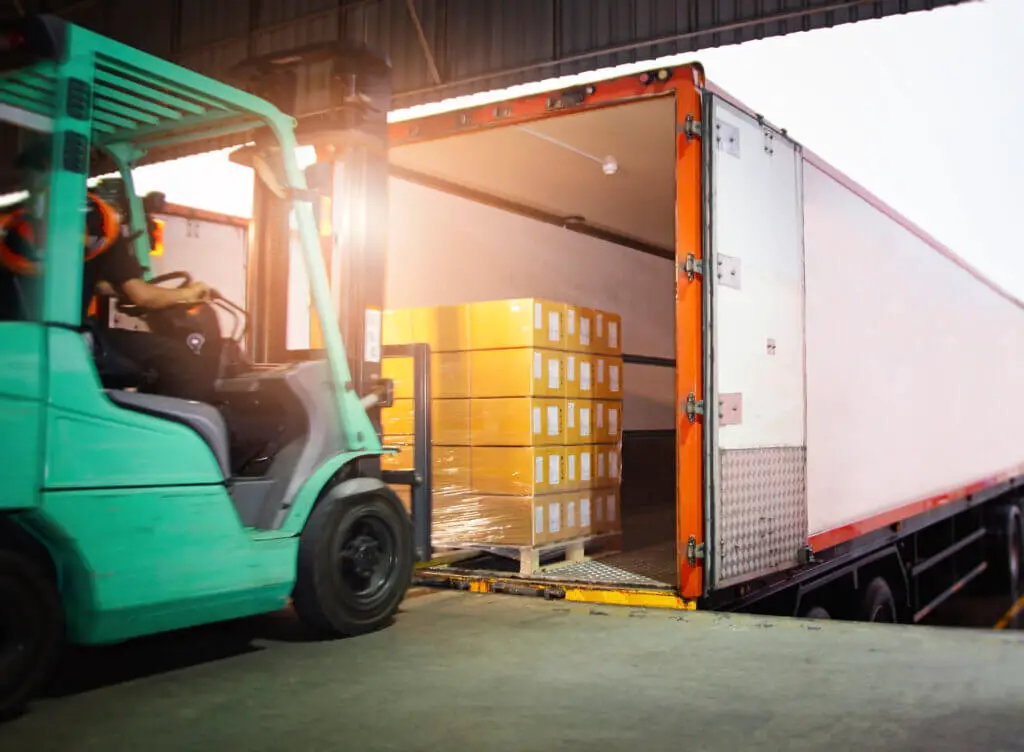Loading a trailer with cargo for a trip covering plenty of miles may seem effortless. Perhaps, a newbie trucker would want to stack up his trailer with his goods so long as they fit and get going. Not only is this unsafe for the trucker and his vehicle, but it also poses a litany of threats to other road users.
Add to that the possibility of paying fines, being delayed, or even ending up in jail when caught by the vehicle inspection officers of the DOT. It immediately becomes apparent why it is essential to do proper cargo loading and distribution on your trailer before moving.
In most cases, achieving properly loaded and distributed cargo is challenging. Truckers and professional on-loaders often require a combination of calculations and creativity to succeed. This article looks into what needs to be considered before loading cargo on your trailers. We also discuss how to go about it to achieve the best results. Why is this so important to even consider at first?

Why Bother Yourself With The Weight And Arrangement At All?
As a road user, many things already require your rapt attention for your safety and those of others while driving. Talk less of staying on the wheels of a vehicle that often weighs between 40,000 to 80,000 pounds- sometimes even more. You, therefore, do not want to make your journey more burdensome for any of the following reasons.
- Overloading your trailer or not paying proper attention to weight distribution gives you less control of your vehicle. It is easy for a poorly loaded truck to spin out of control, even at moderate speeds. When trailers are overloaded or not balanced out well enough, they swirl left and right on the road, posing a significant risk to other road users. It has been found that trucks veering off their lane or tipping over are major causes of road accidents. Furthermore, when trucks are overloaded, the responsiveness of their braking systems becomes significantly altered. Traction of the tires on roads becomes excessive, inadequate, or sometimes a combination of both where there is no even distribution, further elevating the risks of an accident.
- You could also find yourself in the net of the Department of Transportation (DOT) when caught. This usually comes with paying huge fines. In some states, this singular act can land one in jail. Come to think of it. Except the cargo is a single bulky unit, there is no reason important enough to overload your truck and compromise road safety. This often makes the officers go really hard on you. Besides, if you must carry a weight more than the legally approved, you must get a permit before going ahead.
- You can also lose valuable time when caught. Inspection officers would ensure that cargo on an overloaded vehicle is reduced. Improperly distributed goods will also have to be rearranged. This takes a lot of economic hours to achieve. Worse still, you may have to wait for another vehicle to come to your rescue if the other options cannot immediately solve the problem, a completely avoidable situation from the get-go.
- You also risk causing enormous damage to your vehicle. Overloading adds more strain to parts of your truck, such as the brakes and its engines. This also puts unnecessary pressure on your tires, increasing the risk of wear, tear, or burst. Needless to say, a faulty part of a vehicle is an additional risk to road users of its own.
6 Useful Tips For Proper Weight Distribution
The following tips will help circumvent the issues listed above when put into careful consideration.
Your truck weight

The weight of the truck is usually the first thing to consider. Every trailer has a maximum load capacity that it can convey. This is the Gross Vehicle Weight Rating (GVWR) for your truck. You can find it on the trailer’s VIN label. Note that the GVWR already includes the weight of the vehicle itself. To find the maximum load your truck can convey, you will need to subtract the truck’s weight when empty from its GVWR.
You can easily get the weight of your truck at a weighing station near you. Also, be mindful that the vehicle’s fuel tank should be full before weighing. This puts into consideration the worst possible scenario for the maximum weight permissible on the road. After getting these figures, aiming for 80% of overall weight when loading is generally considered safe.
In the US, a commercial motor vehicle’s maximum weight to ply roads and highways is 80,000 pounds. Bear this in mind when doing your calculations to avoid being sanctioned.
Appropriate tongue weight
In considering what the appropriate tongue weight for your trailer is, you first have to know what the trailer’s gross weight is. The tongue weight is the weight the frontal part of your trailer exerts on the hitch ball. The hitch ball sometimes rests on the driver-axle of the truck or forms an attachment between the truck and the trailer.
When proper tongue weight is determined, it can help indicate the distribution of the cargo on the trailer. This could show that shipment is packed more at the trailer’s front or back. When you have more load at the back of the trailer, the point of attachment between the truck and the trailer tends to tilt upwards, above its ideal plane. An unbalanced trailer-truck attachment can lead to severe problems with vehicle control.
The same is true when loads are packed too much in the front of the trailer. As a rule of thumb, between 10% and 15% of the gross trailer weight should rest on the tongue for a 48-foot trailer. The numbers can be extended between 20% and 25% for a 53-foot trailer. Maintaining the proper tongue weight lets you control your truck better, even at considerably high speeds.
Determine the center of your trailer.

Getting this right will help you achieve a more outstanding balance. The point is to find where your trailer’s center of gravity and take advantage of it. It is usually the midpoint between the kingpin that attaches the trailer to the truck and the median of suspension that holds the rear axle.
Think of your trailer as a see-saw. At what point would it find its balance if placed on a hinge? Then, you can conveniently put the heaviest goods at this balance point. It is essential to state here that some truckers regard the 60-40 rule as appropriate for cargo distribution. In this case, 60% of the goods are loaded at the front, while 40% are placed at the back. While this may sometimes achieve the desired result, it may not always be the best option.
Loading pallets
When you have to stack your trailer with pallets, evenly distributing the weight is generally considered ideal so that the maximum permissible load on each axle is maintained. The maximum payload is usually 1000 pounds for the steering axle, 20,000 ponds for the drive axle, and 24,000 ponds for the trailer axle.
Arranging pallets in a truck need plenty of creativity. A standard pallet is about 40 inches by 48 inches. This can allow you to load up to 26 pallets when placed front to back on the 48-inch side. This can be increased to 30 pallets when you get artsier with the arrangement. Lining half of the pallets, front to back, on the 40-inch side can help you achieve this.
Very importantly, you want to ensure that the pallets sitting on each axle weigh about 800 pounds per foot of trailer length. This has to be considered, especially when the pallets come in varying weights other than the standard. This may imply that you arrange the pallets in rows of twos and ones intermittently, as long as there is an even distribution of weight from front to back and from side to side.
If there are spaces between the cargo and the wall of the trucks, inflatable airbags can be used to prevent cargo movement within the trailer. Generally, restraining straps and decking bars can also be used to avoid the unwanted movement of cargo in the trailer.
When your cargo is another vehicle
This is sometimes possible when, for instance, you want to deliver a new car to its owner. Some extra steps must be taken to ensure the safety of everything involved.
Firstly, the vehicle has to be carefully moved into the trailer with the help of a ramp. After that, the shocks of the vehicle should be pressed by about half. This is to prevent undesirable bouncing movements in the trailer. Next is to saddle the vehicle’s suspension with straps and tie-downs to secure its body. Do some random pushes and shoves on the vehicle to ensure that it is tightly positioned in the trailer before getting on the road.
Engage your customer
Sometimes, the customer whose cargo you are transporting has good knowledge of the weight of their goods. Engaging them in determining how best to load your trailer is useful. Only some customers are conversant with the exact truck type you are driving, even when they know so much about their own goods. Try to discuss with them a point of convergence of their ideas with yours.
Also, some customers may prove challenging to work with in this regard. They are probably more interested in getting their loads off its present location. Find a way to speak to them amicably, emphasizing the importance of carefully loading your truck. Sometimes too, you may need to call your dispatcher to help intervene.
Conclusion
It is primarily your responsibility to ensure that your trailer is loaded correctly for the safety of all parties. Also, when you are caught violating safety regulations regarding the loading of vehicles, you will have to bear the cost if you are an owner-operator of the truck. Your company may be held responsible if you are an employee. Either way, this does not look good.
